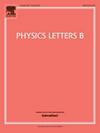Low scale leptogenesis and TM1 mixing in neutrinophilic two Higgs doublet model (ν2HDM) with S4 flavor symmetry
IF 4.5
2区 物理与天体物理
Q1 ASTRONOMY & ASTROPHYSICS
引用次数: 0
Abstract
We study a modified version of the Standard Model that includes a scalar doublet and two right-handed neutrinos, forming the neutrinophillic two higgs doublet () framework. For the two Higgs-doublet vacuum expectation values satisfying , this model operates at a TeV scale, bringing the RHNs within experimental reach. To further enhance its predictive power, we introduce an flavor symmetry with five flavons, resulting in mass matrices that realize the so-called Trimaximal mixing scheme. The model effectively explains lepton masses and flavor mixing under the normal ordering of neutrino masses, predicting that the effective neutrino mass in 0 decay lies between [4 - 5] meV, significantly lower than the sensitivity limits of current experiments. We also investigate how this framework could support low-scale leptogenesis as a natural way to explain the observed imbalance between matter and antimatter in the Universe. This work explores how neutrino physics, flavor symmetry and baryon asymmetry are connected, providing a clear framework that links theoretical predictions with experimental possibilities.
具有S4风味对称的嗜中性双希格斯双重态模型(ν2HDM)中的小尺度纤生和TM1混合
我们研究了一个修正版的标准模型,其中包括一个标量双重态和两个右手中微子,形成了亲中微子的两个希格斯双重态(ν2HDM)框架。对于满足v2<;<;v1的两个希格斯双重态真空期望值,该模型在TeV尺度下运行,使rhn在实验范围内。为了进一步提高其预测能力,我们引入了一种含有五种黄酮的S4×Z4风味对称,从而得到了实现所谓的Trimaximal TM1混合方案的质量矩阵。该模型有效地解释了中微子质量正常排序下的轻子质量和风味混合,预测0νββ衰变的有效中微子质量在[4 - 5]meV之间,显著低于当前实验的灵敏度极限。我们还研究了这个框架如何支持低尺度的纤体发生,作为解释宇宙中物质和反物质之间观察到的不平衡的自然方式。这项工作探索了中微子物理、风味对称和重子不对称是如何联系在一起的,提供了一个清晰的框架,将理论预测与实验可能性联系起来。
本文章由计算机程序翻译,如有差异,请以英文原文为准。
求助全文
约1分钟内获得全文
求助全文
来源期刊

Physics Letters B
物理-物理:综合
CiteScore
9.10
自引率
6.80%
发文量
647
审稿时长
3 months
期刊介绍:
Physics Letters B ensures the rapid publication of important new results in particle physics, nuclear physics and cosmology. Specialized editors are responsible for contributions in experimental nuclear physics, theoretical nuclear physics, experimental high-energy physics, theoretical high-energy physics, and astrophysics.
 求助内容:
求助内容: 应助结果提醒方式:
应助结果提醒方式:


